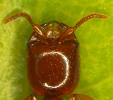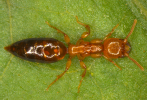Scientific name
Apenesia sahyadrica Azevedo & Waichert
Taxonomic position
Hymenoptera: Chrysidoidea: Bethylidae
Diagnosis
Female: Wingless. Head, mesosoma and legs castaneous / reddish brown to
yellowish brown; metasoma dark pitchy brown and shiny, tergites posteriorly paler, reddish brown. Head large, quadrate with much reduced, elliptical eyes with indistinguishable facets; ocelli absent. Mandibles with two large apical teeth, upper tooth smaller. Clypeus truncate.

 Head, female
Male: Head, female
Male: Fully winged and slightly smaller than females. Head and mesosoma black, metasoma dark castaneous; mandibles, antennae, palpi and legs castaneous; wings subhyaline. Mandibles with five apical teeth, lower tooth larger than rest. Ocelli present. Clypeus rounded.
Males and females very strongly sexually dimorphic. Azevedo & Waichert (2006) described both sexes in detail with illustrations.


 Adult female, dorsal view Adult female, dorsal view
Distribution
India: Originally described from Western Ghats. Presently mass produced and used in the augmentative biological control of coffee white stem borer, Xylotrechus quadripes Chevrolat (Coleoptera: Cerambycidae) in Karnataka, Kerala, and Tamil Nadu.
Hosts / Biology
References
- Azevedo, C.O. & Waichert, C. 2006. A new species of Apenesia (Hymenoptera, Bethylidae) from India, a parasitoid of coffee white stem borer, Xylotrechus quadripes (Coleoptera, Cerambycidae). Zootaxa, 1174: 63-68.
- Seetharama, H.G., Vinod Kumar, P.K., Sreedharan, K. and Vasudev, V. 2002. Biology and observations on the field parasitism by Apenesia sp. (Hymenoptera: Bethylidae), an indigenous parasitoid of the coffee white stem borer, Xylotrechus quadripes, pp. 513-519. In: Proceedings of the 15th Plantation Crops Symposium PLACROSYM XV (Eds. K. Sreedharan et al.), Central Coffee Research
Institute, Chikmagalur, Karnataka.
|